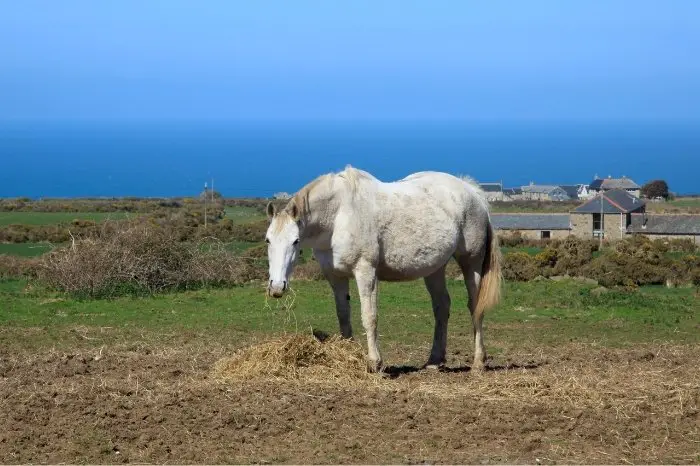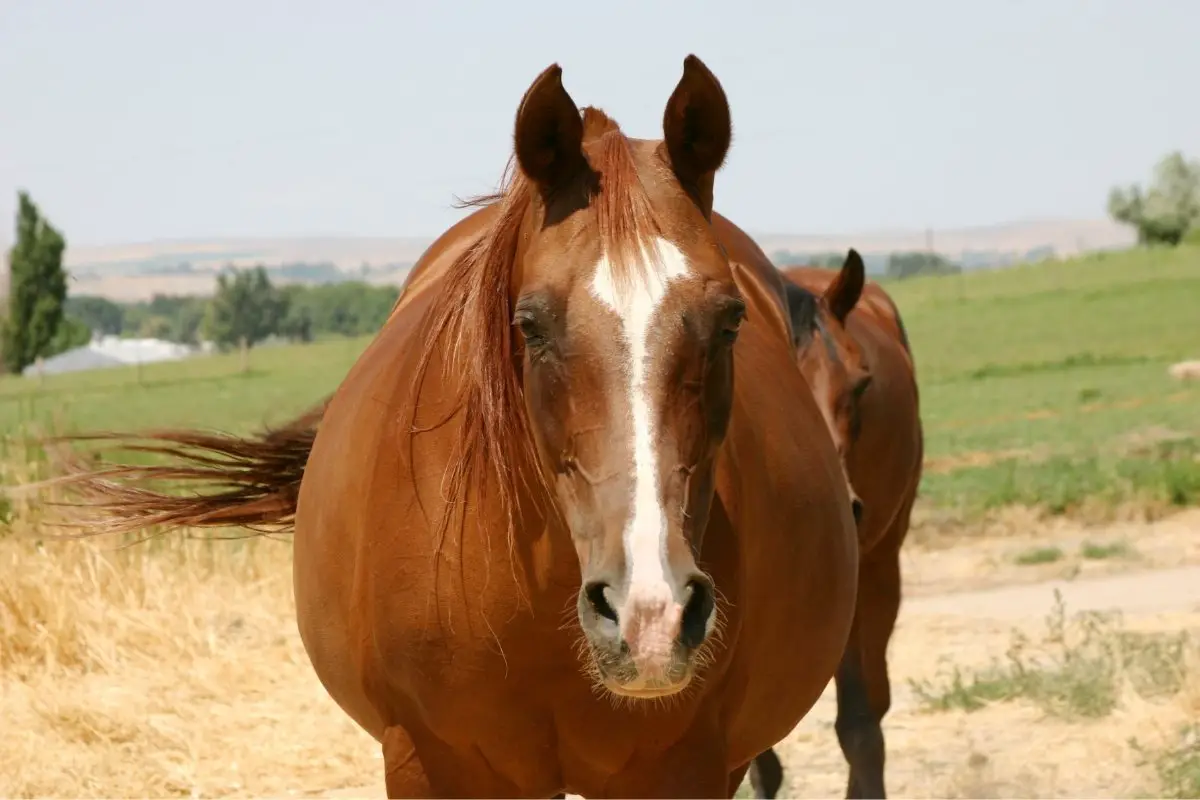Last Updated on October 7, 2022
Untreated Cushing’s disease in horses is a painful and debilitating condition that can be very detrimental to the animal. Many horse owners worry about the financial cost of medication for Cushing’s disease in horses, but if left untreated Cushing’s disease in horses will lead to many secondary health problems.
Let’s find out everything you need to know about Cushing’s disease in horses, including why early treatment is the best option!
What Is Cushing’s Disease In Horses?
Cushing’s disease in horses is an endocrine disorder, meaning it affects the hormonal system. It is more correctly known as pituitary pars intermedia dysfunction (PPID), and is very common in older horses, ponies, and donkeys. Most horses with this condition are diagnosed in their geriatric years, but early testing can pick it up much earlier.
PPID occurs when the pituitary gland develops a benign tumor which causes it to dysfunction. Normally, the pituitary gland performs a feedback role – telling metabolic and reproductive functions when to stop and start. When Cushing’s disease occurs, the pituitary gland overproduces some hormones, telling the body to continue carrying out certain functions long after they should have stopped.
The main culprit is the overproduction of adrenocorticotropic hormone (ACTH). When this is overproduced, the horse will develop a huge range of disorders associated with metabolic balance, as well as blood pressure and electrolyte levels.
Check Out Can Horses Eat Sunflower Seeds?
Symptoms Of Cushing’s In Horses
The classic symptoms associated with Cushing’s disease in horses are a long wavy coat, excessive sweating, loss of muscle mass, and increased thirst and urination. However, these commonly don’t occur until the tumor has progressed for several years, and veterinarians are now asking horse owners to focus on the early signs of Cushing’s in horses.
For example, in the early stages of PPID the horse may just be slightly less energetic than usual or have a reduced exercise tolerance. Whilst it is easy to brush this off as ‘old age’, early testing for PPID can reap huge rewards.
Veterinarians are now advocating early testing for PPID in horses as it has been shown that early diagnosis and treatment can slow the progression of the disorder. The growth of the tumor itself cannot be halted or reversed, but prompt and effective treatment can help to reduce the long-term debilitating effects of the symptoms of this disease.
What Happens If Cushing’s Is Left Untreated?
Unfortunately, if left untreated then Cushing’s disease in horses can lead to several unpleasant and often life-threatening secondary conditions. Some symptoms of PPID in horses can be managed with changes to the horse’s routine and care, but others are more difficult to manage without treatment.
Horses with PPID do not shed their coat normally and are also prone to excessive patchy sweating. This leads to the skin becoming sore and inflamed, resulting in secondary skin infections. Clipping of the coat can help to improve these problems, but the horse will then require appropriate weatherproof blankets in adverse weather.
Another side-effect of PPID has reduced immunity, so horses with this condition are more likely to succumb to infectious diseases. If they sustain an injury then infection is more likely, and they are prone to problems such as sinusitis, dental infections, parasite overload, and respiratory disease. Even if treatment with antibiotics is initiated, it is likely that the infection will recur when the course of medication has ended.
Most initial diagnoses of PPID in horses are as a result of laminitis, as a result of abnormal glucose and fat metabolism. You may also hear this referred to as insulin dysregulation, and it occurs because of abnormal fat deposits on the crest of the neck, buttocks, and shoulders. Laminitis is an incredibly painful and debilitating condition of the hooves, and if the underlying cause is not treated the patient will not recover.
In Untreated Cushing’s Disease In Horses, the laminitis will recur no matter what treatment the horse is given. This leads to irreversible changes in the hooves of the horse, as the bones start to rotate and sink. In the worst-case scenario, the pedal bone can protrude through the sole of the hoof, resulting in the immediate euthanasia of the horse on humane grounds.
Click Here to Get Info About:
Cushing’s Disease In Horses Life Expectancy
Although Cushing’s disease for horses is a life-long condition without any cure, with the right combination of medication and management strategies your horse can live a long and comfortable life. The best medication for Cushing’s in horses is a drug called pergolide, which is sold under the trade name Prascend. This medication works by controlling drug receptors in the brain, helping to counteract the metabolic imbalances seen in horses with Cushing’s disease.
Horses and ponies with PPID are normally diagnosed between 15 and 20 years of age, and with prompt initiation of treatment, they can live for many comfortable years. The oldest recorded case of a horse with Cushing’s disease is an incredible 42 years old!

The key to success when caring for a horse with Cushing’s disease is to follow a regular testing protocol for ACTH, which will help to identify if any change in the dosage of medication is required. It is also vital to assess the body condition and overall health of the horse regularly, allowing any secondary problems to be identified and treated before they deteriorate to the point that the horse is suffering.
Summary – Untreated Cushing’s Disease In Horses
So, as we have learned, untreated Cushing’s disease in horses leads to complex health problems such as laminitis, dental disease, and long-term weight loss. The treatment for Cushing’s disease is highly effective at keeping these problems at bay, and many horses with Cushing’s disease go on to live long and happy life. An early diagnosis of Cushing’s disease leads to greater control of symptoms and secondary health problems.
We’d love to hear your thoughts on Untreated Cushing’s Disease In Horses! Do you know of a case where untreated Cushing’s disease in horses has resulted in serious secondary health problems? Or perhaps you’ve got some questions about the best management and care for a horse with Cushing’s disease? Leave a comment below and we’ll get back to you!

Kate Chalmers is a qualified veterinary nurse who has specialized in horse care for the vast majority of her career. She has been around horses since she was a child, starting out riding ponies and helping out at the local stables before going on to college to study Horse Care & Management. She has backed and trained many horses during her lifetime and competed in various equestrian sports at different levels.
After Kate qualified as a veterinary nurse, she provided nursing care to the patients of a large equine veterinary hospital for many years. She then went on to teach horse care and veterinary nursing at one of the top colleges in the country. This has led to an in-depth knowledge of the care needs of horses and their various medical ailments, as well as a life-long passion for educating horse owners on how to provide the best possible care for their four-legged friends.
Kate Chalmers BSc (Hons) CVN, Dip AVN (Equine) Dip HE CVN EVN VN A1 PGCE


